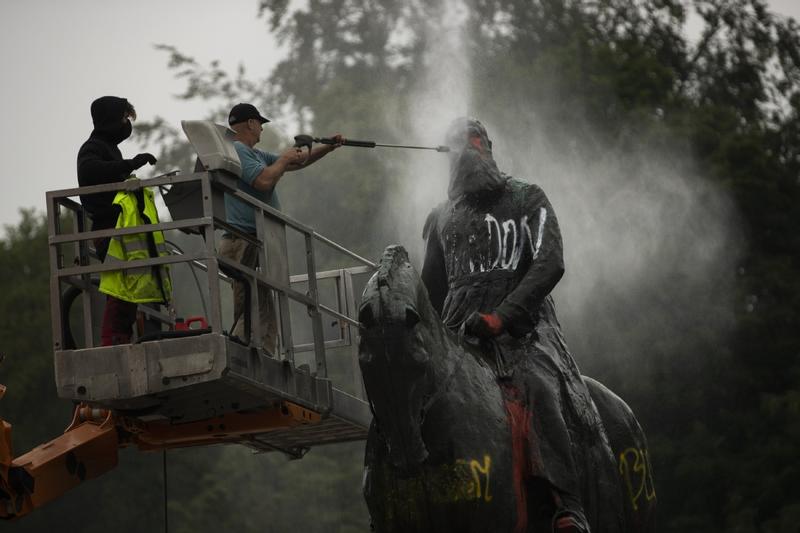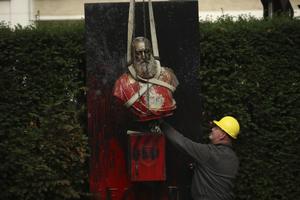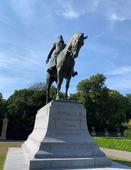Statues of the former monarch Leopold II targeted by protesters
 Workers clean graffiti from a statue of King Leopold II in Brussels, the Belgian capital. The statue was targeted by protesters during a demonstration in June. (FRANCISCO SECO / AP)
Workers clean graffiti from a statue of King Leopold II in Brussels, the Belgian capital. The statue was targeted by protesters during a demonstration in June. (FRANCISCO SECO / AP)
A huge equestrian statue of King Leo-pold II that has stood in central Brussels since 1926 has had to be cleaned repeatedly in recent months after being vandalized by activists protesting against racism and colonialism.
In a demonstration that drew 10,000 people to the Belgian capital on June 7, protesters climbed the statue, chanting "murderers" and waving the national flag of the Democratic Republic of the Congo, a former Belgian colony.
Early this month, a bust of the monarch in the garden of the Royal Museum of Central Africa, or RMCA, in Brussels was daubed with red paint, the third time it had been defaced. A "BLM" sign was scrawled on the pedestal, a reference to the Black Lives Matter movement.
Leopold II, who reigned from 1865 to 1909, has become the focal point as Belgians reassess their country's colonial legacy. Historians believe he was responsible for the deaths of millions of Congolese during colonial days.
In recent months, several statues of the former king have been removed from Belgian cities, including Brussels, Antwerp, Ghent, Leuven and Mons.
Gia Abrassart, an activist and founder of Cafe Congo, a cultural salon in Brussels, said the statues definitely had to go.
"For me, it's really important to be able to rewrite a shared collective story between Belgium and D. R. Congo," she said.
Jean Carlier, a 74-year-old Belgian, disagreed and said that destroying historical monuments makes no sense.
"In two or three generations, people will probably consider us stupid to destroy our own monuments. It is our history," he said.
Many petitions have been raised throughout Belgium demanding the removal of colonial statues, but there have also been a number in favor of them remaining.
A recent study by the University of Antwerp and the RMCA also sent conflicting signals.
About 60 percent of Belgians want to see statues of colonial figures removed from public places and relocated to museums, while 75 percent said the country should apologize to the D.R. Congo for the colonial past. At the same time, 50 percent of those polled feel that Belgium did more good than harm in colonizing the Central African nation.
The poll respondents, who also took a colonial history test, averaged only 7.5 points out of a possible 20, with fewer than one-third scoring 10 points or more.
The result was widely attributed to a serious lack of education about colonial history in Belgian schools in the past 20 years. Belgians attending school two decades ago were taught that Leopold II was a philanthropist who brought civilization to the Congolese, building roads, schools and hospitals. However, there was no mention of his ruthless treatment of the people and bloody exploitation of resources.
 The statue of Leopold II in central Brussels is cleaned on June 11. (FRANCISCO SECO / AP)
The statue of Leopold II in central Brussels is cleaned on June 11. (FRANCISCO SECO / AP)
Flemish Education Minister Ben Weyts recently proposed that colonialism be part of the standard curriculum at schools in the Dutch-speaking region. Caroline Desir, education minister in the French-speaking Wallonia-Brussels region, supported the reform proposal, which has to be approved by local parliaments.
In mid-June, the Belgian parliament approved a proposal to set up a parliamentary commission to examine the country's colonial past, mainly in D. R Congo, but also in Rwanda and Burundi, which were colonized years after the death of Leopold II.
Parliament Speaker Patrick Dewael, who put forward the motion, described the panel as a sort of Truth and Reconciliation Commission, a reference to the body formed in South Africa in 1996 after the end of apartheid.
On June 30, the 60th anniversary of D. R Congo's independence, Belgian King Philippe surprised many people by sending a letter to Felix Tshisekedi, the African nation's president, expressing his "deepest regrets" for the "suffering and humiliation" inflicted during colonial rule.
"During the days of the Congo Free State, acts of violence and cruelty were committed, which still weigh on our collective memory," the letter stated.
Congo Free State, the privately owned territory held by Leopold II from 1885 to 1908, is part of present-day D. R. Congo and an area 76 times that of Belgium.
The letter marked the first time a Belgian king had publicly condemned the country's colonial past, but it stopped short of an apology. Early last year, a group of experts from the United Nations called on Belgium to apologize for its colonial history and crimes committed during a dark chapter in the country's past.
However, with Prime Minister Sophie Wilmes sworn in only in March after being nominated by the king to form a permanent minority government during the COVID-19 pandemic, Belgium is still struggling to form a coalition administration after an election in May last year.
Unveiling a commemorative plaque on June 30 at Ixelles Town Hall in Brussels to mark the 60th anniversary of D. R. Congo's independence, Wilmes said, "The time has come for Belgium to embark on a journey of research, truth and remembrance."
 A bust of Leopold II is removed by crane from a park in Ghent, Belgium, at the end of June. (FRANCISCO SECO / AP)
A bust of Leopold II is removed by crane from a park in Ghent, Belgium, at the end of June. (FRANCISCO SECO / AP)
Leopold's ghost
Born on April 9, 1835, five years after Belgium's independence from the Netherlands, Leopold II became king in December 1865 on his father's death.
At the time, when major European powers had colonies in Africa and other parts of the world, the king, a cousin of Britain's Queen Victoria, sighed in French that Belgium was "petit pays, petits gens" ("small country, small people").
In 1879, he hired the Welsh-born explorer and journalist Henry Morton Stanley to represent him in Africa. For the next five years, Stanley traveled the Congo River Basin, setting up trading posts, building roads and persuading local chiefs, who were mostly illiterate, to sign treaties with Leopold II.
Through his public relations skills, the king persuaded the US and major European nations to recognize the area as his private fiefdom. He named the world's only private colony the Congo Free State, a place he never visited. US journalist and historian Adam Hochschild describes in his book King Leopold's Ghost: A Story of Greed, Terror and Heroism in Colonial Africa how the king embarked on an ultimately successful effort to make a vast fortune from the new possession.
For some years, ivory was a principal source of great wealth drawn from the new colony by Leopold and his associates.
By the early 1890s, natural rubber in the Central African rainforest had emerged as a new and lucrative source of wealth. Detachments of Leopold's 19,000-strong private army, known as Force Publique, would march into a village, hold the women hostage and force the men into the rainforest to gather a monthly quota of the commodity.
Hochschild writes, "As the price of rubber soared, the quotas increased, and as vines near a village were drained dry, men desperate to free their wives and daughters would have to walk days or weeks to find new vines to tap."
Forced labor was also used to operate other parts of the economy in the colony, from building roads to chopping wood for use in steamboat boilers.
The effects were devastating. Numerous female hostages starved, and many of the men harvesting rubber were worked to death, according to the book, which was made into a documentary.
In one particularly cruel practice aimed at preventing Congolese troops in Force Publique from wasting bullets or saving them for use in a mutiny, the soldiers had to present the severed hand of each rebel they killed to their white officers.
"Baskets of severed hands thus resulted from the expeditions against rebels. If a soldier fired at someone and missed, or used a bullet to shoot game, he then sometimes cut off the hand of a living victim to be able to show it to his officer," Hochschild writes.
After journalists' reports triggered an international outcry against Leopold's crimes in Africa, he was forced to relinquish his territory in 1908 to the Belgian government, which renamed it the Belgian Congo.
Leopold died the following year and was succeeded by his nephew, Albert I, as his only legitimate son, also named Leopold, had died in 1869 at age 9.
Hochschild's book also makes a brief mention of how Leopold II invested his Congolese profits in a railway in China in 1897-a clear reference to the Beijing-Hankou line. He viewed China in the same manner as the "magnificent African cake"-as a feast to be consumed, and he was just as ready to invite himself to the table.
While Leopold failed to realize many of his Chinese ambitions, many of the 540 workers brought from the country to labor on a Congolese railway in 1892 lost their lives.
Hochschild puts the Congolese death toll under Leopold at more than 10 million, based on population estimates from 1880 to 1920.
 The newly cleaned statue of Leopold II stands in central Brussels. (CHEN WEIHUA / CHINA DAILY)
The newly cleaned statue of Leopold II stands in central Brussels. (CHEN WEIHUA / CHINA DAILY)
Death toll challenged
In 1998, when civil war was raging in D. R.Congo and Hochschild's book was published, the work focused global attention on the atrocities committed by Leopold. Despite its rich natural resources, the country remains one of the poorest nations in the world.
Guido Gryseels, director of RMCA, said the book is very well written and the facts are basically all true, but Hochschild mainly uses a journalistic style, and there are "errors and exaggeration".
Gryseels said a death toll of more than 10 million "would be simply impossible", adding, "There were a lot of victims, but we believe the number is somewhere between 1 million and 2 million."
The RMCA has also become a target in the ongoing debate despite its decolonization efforts following a five-year renovation project undertaken before it reopened in December 2018.
An ethnography and natural history museum, its origins can be traced to Leopold II's attempts to showcase his Congo Free State at world fair in Brussels in 1897.
Leopold brought 267 Congolese to Brussels to put on display during the fair, an event later decried as a "human zoo".
At the 1958 World Fair in Brussels, Congolese men, women and children were again put on show in traditional dress in tropical gardens behind a bamboo perimeter fence.
Gryseels said the museum now has a very different narrative of the colonial past.
"Basically, we consider colonialism to be immoral. Colonialism is by definition a form of government based on military occupation, racist and authoritarian rule, and exploitation of a country," he said.
He is pleased with the museum's renovation work, but feels that issues such as restitution and the link between colonialism and racism could be more fully explained
One innovative new exhibit features the names of Congolese who died at the 1897 world fair painted in reverse in large black letters on a glass wall. If the sun comes through in late afternoon, the shadows of the names are projected on to the white marble of the inner wall, where the names of Belgians who died in Congo are etched.
Visitors now enter the museum through a new glass building, but the original structure, which opened in 1910 and was designed by the French architect Charles Girault, still features dozens of Leopold II's royal monogram "LL".Gryseels said they cannot be removed, as they are protected.
"We no longer consider him a hero," he said of Leopold.
Artists of African descent took part in creating some new permanent exhibits at the museum, and nine of the 75 scientists now working there are of Congolese or other African origin.
Abrassart, the Congolese-Belgian activist, said she is not happy with the changes at the museum, because "the ideological influence of Leopold II is still there". She added that it is important to highlight "how Belgium got rich thanks to the wealth of Congo".
Gryseels, RMCA director since 2001, believes the parliamentary commission will produce a resolution recommending that the Belgian government apologize to and compensate the Congolese people.
"I think damages will be paid, but I don't know in what form. It may be through scholarships, supporting cultural activities, restitution of African cultural heritage, or maybe in monetary form," he said.


